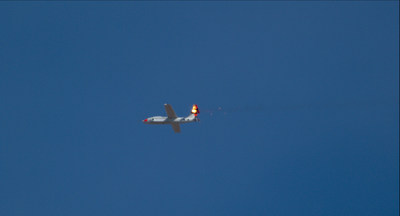By Nicole DiGiose, content editor
Drones with bad intentions, beware! In a live-fire demonstration at the U.S. Army’s White Sands Missile Range in New Mexico, a 30-kilowatt class laser weapon system developed by Lockheed Martin took down five unmanned aerial vehicles (UAVs) with a 100% success rate. This proved that an advanced system of sensors, software, and specialized optics can deliver decisive lethality against threatening UAVs.

ATHENA brought down five UAVs with 10.8-foot wingspans. Image source: Lockheed Martin.
In August, the system, dubbed Advanced Test High Energy Asset (ATHENA), shot down the UAVs, which had 10.8-foot wingspans. To do so, the prototype employed advanced beam control technology and a fiber laser in the latest series of tests. Lockheed Martin partnered with Army Space and Missile Defense Command on a cooperative research and development agreement to test ATHENA.
As a transportable, ground-based system, ATHENA serves as a low-cost test bed for demonstrating technologies required for military use of laser weapon systems. It uses Lockheed Martin’s 30-kilowatt Accelerated Laser Demonstration Initiative (ALADIN) that provides efficiency and lethality in a design that scales to higher power levels. As for what powers ATHENA, credit goes to a compact Rolls-Royce turbo generator.
See for yourself! Watch ATHENA in action below.
“The tests at White Sands against aerial targets validated our lethality models and replicated the results we’ve seen against static targets at our own test range,” said Keoki Jackson, Lockheed Martin’s chief technology officer. “As we mature the technology behind laser weapon systems, we’re making the entire system more effective and moving closer to a laser weapon that will provide greater protection to our warfighters by taking on more sophisticated threats from a longer range.”
Impressively, the system defeated airborne targets in flight by causing loss of control and structural failure. During these studies, Lockheed Martin and the U.S. Army will conduct post-mission reviews, and the data collected will be used to further refine the system, improve model predictions, and inform development of future laser systems.
Advertisement
Learn more about Electronic Products Magazine





